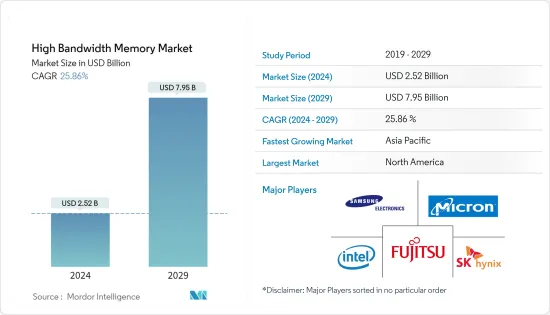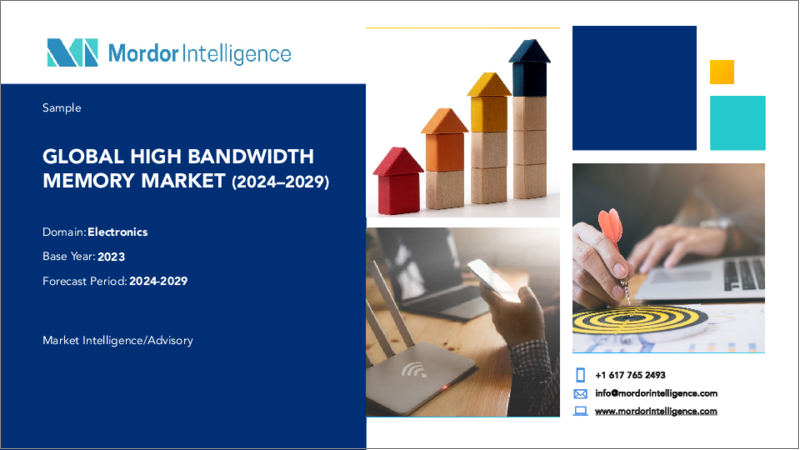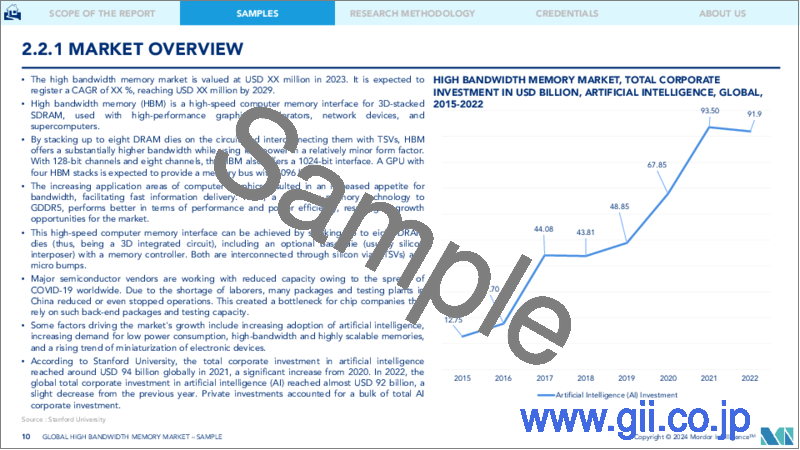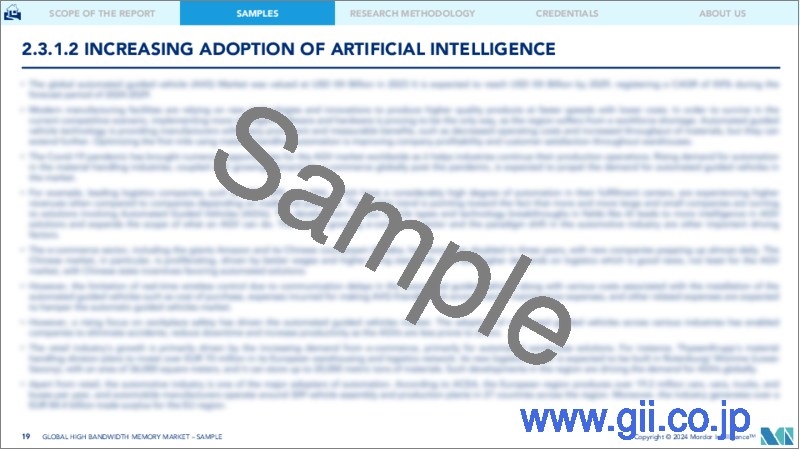|
|
市場調査レポート
商品コード
1435809
HBM(High Bandwidth Memory):市場シェア分析、産業動向と統計、成長予測(2024年~2029年)High Bandwidth Memory - Market Share Analysis, Industry Trends & Statistics, Growth Forecasts (2024 - 2029) |
||||||
カスタマイズ可能
適宜更新あり
|
|||||||
| HBM(High Bandwidth Memory):市場シェア分析、産業動向と統計、成長予測(2024年~2029年) |
|
出版日: 2024年02月15日
発行: Mordor Intelligence
ページ情報: 英文 120 Pages
納期: 2~3営業日
|
- 全表示
- 概要
- 目次
HBM(High Bandwidth Memory)市場規模は、2024年に25億2,000万米ドルと推定され、2029年までに79億5,000万米ドルに達すると予測されており、予測期間(2024年から2029年)中に25.86%のCAGRで成長します。

HBM市場の成長を促進する主な要因には、高帯域幅、低消費電力、拡張性の高いメモリに対するニーズの高まり、人工知能の採用の増加、電子デバイスの小型化傾向の高まりなどが含まれます。
主なハイライト
- HBMは、3DスタックSDRAM用の高速コンピュータメモリインターフェイスであり、通常は高性能グラフィックアクセラレータ、ネットワークデバイス、スーパーコンピュータで使用されます。
- HBMは、回路上に最大8つのDRAMダイをスタックし、それらをTSVで相互接続することにより、比較的マイナーなフォームファクタで消費電力を抑えながら、大幅に高い帯域幅を提供します。また、128ビットチャネルと合計 8チャネルを備えたHBMは、1024ビットインターフェイスを提供します。したがって、4つのHBMスタックを備えたGPUは4096ビットのメモリバスを提供します。
- グラフィックアプリケーションの成長に伴い、高速な情報配信(帯域幅)に対する欲求も高まっています。したがって、HBMメモリは、パフォーマンスと電力効率の点で以前に使用されていたGDDR5よりも優れたパフォーマンスを発揮し、HBM市場に成長機会をもたらします。
- さらに、主要な半導体ベンダーは、COVID-19の世界の蔓延により、生産能力を削減して業務を行っています。さらに、労働力不足により、中国の多くの包装工場や検査工場が操業を縮小、あるいは停止しました。これは、そのようなバックエンドパッケージとテスト能力に依存するチップ企業にとってボトルネックとなっていました。
- ただし、市場の成長を促進する要因には、人工知能の採用の増加、低消費電力、高帯域幅、拡張性の高いメモリに対する需要の増加、電子デバイスの小型化傾向の高まりなどが含まれます。
HBM市場動向
自動車およびその他のアプリケーション分野は大幅な成長が見込まれる
- HBMのアプリケーションは、特に自動運転車やADAS統合の台頭により、自動車分野に広がっています。自動車産業の進歩により、高性能メモリの採用が促進され、HBMの成長がサポートされています。
- HBMは、2.5Dテクノロジーを使用して従来のDRAMを改良することで進化し、信号を駆動するために必要な電力を削減し、RC遅延を最小限に抑えながらCPUに近づけます。自動運転市場は拡大しており、環境の解釈と分析にデータセットを広範囲に使用しています。事故や差し迫った大災害を防ぐために、データ処理は非常に速いペースで実行されます。高速で強力なGPUに対する需要により、システムに搭載されるHBMの需要が増加しています。
- 先進運転支援技術は、自動運転と並んで自動車業界で非常に普及しています。以前のADAS設計では、当時容易に入手できたため、DDR4やLPDDR4などのメモリチップが使用されていました。しかし、自動車業界は費用対効果からより優れた性能パラメータへ移行しているため、ADASメーカーはHBMテクノロジーを設計アーキテクチャに組み込むようになっています。
- 自動車技術の急速な進歩と自動車におけるエッジ技術の利用の増加により、この分野のHBMとDDRAMの売上が増加すると考えられます。
北米が市場で最大のシェアを握る
- 北米でのHBMメモリの採用率の高さは主に、高速データ処理のために高帯域幅のメモリソリューションを必要とするハイパフォーマンスコンピューティング(HPC)アプリケーションの成長によるものです。 AI、機械学習、クラウドコンピューティングの市場の拡大により、北米におけるHPCの需要が増加しています。
- 業界全体でテクノロジーが急速に変化し、大量のデータが生成されるため、より効率的な処理システムの必要性が生じています。これらは、この地域のHBM市場の需要を促進する要因の一部でもあります。
- さらに、米国政府は、国内の多くのデータセンターを統合することで納税者への投資収益率を高めながら、より良いサービスを国民に提供するために、データセンター最適化イニシアチブ(DCOI)を開始しました。統合プロセスには、超大規模データセンターを構築し、パフォーマンスの低いデータセンターを閉鎖するプロセスが含まれます。Cloudsceneによると、2022年 1月の時点で米国には約2,701のデータセンターがあります。
- さらに、北米のメモリ製造会社は生産拡大の機会を求めています。たとえば、Intelは、HBMを搭載した次世代Sapphire Rapids(SPR)Xeon Scalableプロセッサの発売を発表しました。 Sapphire RapidsでサポートされるDDR5は、サーバーメモリの現在の動向であるDDR4に代わって、CPUで利用できるメモリ帯域幅を大幅に拡張するHBMをサポートすると期待されています。
HBM業界の概要
HBM市場は競争が激しく、複数の大手企業で構成されているため、非常に細分化されています。この業界の競争企業間の敵対関係は主に、イノベーション、市場浸透、競争戦略力による持続的な競争優位性にかかっています。市場は資本集約的であるため、撤退の障壁も高くなります。市場の主要なプレーヤーには、Intel Corporation、Toshiba Corporation、Fujitsu Ltdなどが含まれます。市場における最近の主要な動向には次のようなものがあります。
- 2022年 2月-Advanced Micro Devices Inc.がザイリンクスの買収を発表。同社は、この買収により、初年度の非GAAPマージン、非GAAP EPS、フリーキャッシュフロー創出が増加すると予想しています。さらにAMDは、ザイリンクスの買収により、製品、顧客、市場の高度に補完的な集合体に加え、差別化されたIPとワールドクラスの人材が集まり、業界の高性能で適応性のあるコンピューティング組織が構築されると主張しています。
- 2022年 11月- ハイパフォーマンスコンピューティング(HPC)と人工知能(AI)のための2つの最先端のソリューションが、インテルMaxシリーズ製品ファミリーの一部としてインテルコーポレーションからリリースされました。インテルXeon CPU Maxシリーズ(開発コード名:Sapphire Rapids)HBMとIntel Data Center GPU Maxシリーズ(コード名Ponte Vecchio)、これらの新しいアイテムは、アルゴンヌ国立研究所に建設予定の「Aurora」スーパーコンピューターに動力を供給します。
その他の特典
- エクセル形式の市場予測(ME)シート
- 3か月のアナリストサポート
目次
第1章 イントロダクション
- 調査の前提条件と市場定義
- 調査範囲
第2章 調査手法
第3章 エグゼクティブサマリー
第4章 市場洞察
- 市場概要
- 産業バリューチェーン分析
- 業界の魅力度-ポーターのファイブフォース分析
- 供給企業の交渉力
- 買い手/消費者の交渉力
- 新規参入業者の脅威
- 代替品の脅威
- 競争企業間の敵対関係の強さ
- COVID-19の市場への影響評価
- 市場促進要因
- 高帯域幅、低消費電力、高拡張性メモリへのニーズの高まり
- 人工知能の採用増加
- 電子デバイスの小型化動向の高まり
- 市場の課題
- HBMに関連する法外なコストと設計の複雑さ
- DRAM市場
- DRAM収益と需要予測(2023年~2028年)
- 地域別DRAM売上高(HBM市場と同じ地域)
- DDR5 RAM製品の現在の価格
- DDR5製品メーカー一覧
第5章 市場セグメンテーション
- アプリケーション別
- サーバー
- ネットワーキング
- コンシューマー
- 自動車・その他のアプリケーション
- 地域別
- 北米
- 米国
- カナダ
- 欧州
- ドイツ
- フランス
- 英国
- その他欧州
- アジア太平洋
- インド
- 中国
- 日本
- その他アジア太平洋
- 世界のその他の地域
- 北米
第6章 競合情勢
- 企業プロファイル
- 主要なHBMメモリダイサプライヤー
- Micron Technology Inc.
- Samsung Electronics Co. Ltd
- SK Hynix Inc.
- 主要な利害関係者プロファイル
- Intel Corporation
- Fujitsu Limited
- Advanced Micro Devices Inc.
- Xilinx Inc.
- Nvidia Corporation
- Open Silicon Inc.
- 主要なHBMメモリダイサプライヤー
第7章 投資分析
第8章 市場機会と今後の動向
The High Bandwidth Memory Market size is estimated at USD 2.52 billion in 2024, and is expected to reach USD 7.95 billion by 2029, growing at a CAGR of 25.86% during the forecast period (2024-2029).

Major factors driving the growth of the high bandwidth memory (HBM) market include the growing need for high-bandwidth, low power consumption, and highly scalable memories, increasing adoption of artificial intelligence, and a rising trend of miniaturization of electronic devices.
Key Highlights
- High Bandwidth Memory (HBM) is a high-speed computer memory interface for 3D-stacked SDRAM, usually used with high-performance graphics accelerators, network devices, and supercomputers.
- By stacking up to 8 DRAM dies on the circuit and interconnecting them by TSVs, HBM offers a substantially higher bandwidth while using less power in a relatively more minor form factor. Also, with 128-bit channels and a total of 8 channels, the HBM offers a 1024-bit interface; a GPU with four HBM stacks would therefore provide a memory bus with 4096 bits.
- With the growing graphics application, the appetite for fast information delivery (bandwidth) has also increased. Therefore HBM memory performs better than a GDDR5, which was used earlier in terms of performance and power efficiency, resulting in growth opportunities for the high bandwidth memory market.
- Moreover, the major semiconductor vendors are working with reduced capacity owing to the spread of COVID-19 worldwide. Additionally, due to the shortage of laborers, many packages and testing plants in China reduced or even stopped operations. This created a bottleneck for chip companies that rely on such back-end packages and testing capacity.
- However, some factors driving the market's growth include the increasing adoption of artificial intelligence, increasing demand for low power consumption, high bandwidth, highly scalable memories, and a rising trend of miniaturization of electronic devices.
High Bandwidth Memory (HBM) Market Trends
Automotive and Other Applications Segment is Expected to Grow Significantly
- The applications of high bandwidth memory are spanning in the automotive sector due to the rise of self-driving cars and ADAS integration, among others. The advancement in the automotive industry has driven the adoption of high-performance memory, which supports the growth of high-bandwidth memory.
- HBM has evolved by improving upon conventional DRAM using 2.5D technology, bringing it closer to the CPU while requiring less power to drive a signal and minimizing RC latency. The autonomous driving market is expanding, extensively using data sets to interpret and analyze the environment. To prevent mishaps and impending catastrophes, data processing is carried out at a very rapid pace. The demand for quick and potent GPUs has increased the demand for high-bandwidth memory to be included in the systems.
- Advanced driver-assistance technologies have become quite popular in the car industry alongside autonomous driving. Earlier ADAS designs use memory chips like DDR4 and LPDDR4 since they were readily available at the time. However, the automobile industry's transition from cost-effectiveness to better performance parameters pushes ADAS makers to incorporate HBM technology into their design architecture.
- The rapid advancement of technology in automobiles and increasing usage of edge technologies in cars will boost the sales of High Bandwidth Memory and DDRAM in the sector.
North America to Hold the Largest Share in the Market
- The high adoption of HBM memories in North America is primarily due to the growth in high-performance computing (HPC) applications that require high-bandwidth memory solutions for fast data processing. HPC demand in North America is growing due to the increasing market for AI, machine learning, and cloud computing.
- The rapidly changing technologies and high data generation across industries create a need for more efficient processing systems. These are also some of the factors driving the demand for the high bandwidth memory market in the region.
- Additionally, the US government has started the Data Center Optimization Initiative (DCOI) to deliver better services to the public while increasing return on investment to taxpayers by consolidating many data centers in the country. The consolidation process includes the process of building hyper-scale data centers and shut-off the underperforming ones. According to Cloudscene, the country has around 2,701 data centers in the United States as of January 2022.
- Moreover, memory manufacturing companies in North America seek production expansions opportunities. For instance, Intel announced the launch of the next generation Sapphire Rapids (SPR) Xeon Scalable processor with high-bandwidth memory (HBM). DDR5, supported by Sapphire Rapids, is expected to replace DDR4, the current trend in server memory, with high-bandwidth memory (HBM) support that significantly expands the memory bandwidth available to the CPU.
High Bandwidth Memory (HBM) Industry Overview
The high bandwidth memory market is highly fragmented as the market is highly competitive and consists of several major players. This industry's competitive rivalry primarily depends on sustainable competitive advantage through innovation, market penetration, and competitive strategy power. Since the market is capital-intensive, the barriers to exit are also high. Some of the key players in the market are Intel Corporation, Toshiba Corporation, Fujitsu Ltd, etc. Some of the key recent developments in the market are -
- February 2022 - Advanced Micro Devices Inc. announced the acquisition of Xilinx. The company expects the purchase to boost non-GAAP margins, non-GAAP EPS, and free cash flow generation in the first year. Furthermore, AMD claims that the Xilinx acquisition brings together a highly complementary collection of products, customers, and markets, as well as differentiated IP and world-class personnel, to build the industry's high-performance and adaptive computing organization.
- November 2022 - Two cutting-edge solutions for high-performance computing (HPC) and artificial intelligence (AI) have been released by Intel Corporation as part of the Intel Max Series product family: the Intel Xeon CPU Max Series (code-named Sapphire Rapids HBM) and the Intel Data Centre GPU Max Series (code-named Ponte Vecchio). The new items will power the forthcoming Aurora supercomputer at Argonne National Laboratory.
Additional Benefits:
- The market estimate (ME) sheet in Excel format
- 3 months of analyst support
TABLE OF CONTENTS
1 INTRODUCTION
- 1.1 Study Assumptions and Market Definition
- 1.2 Scope of the Study
2 RESEARCH METHODOLOGY
3 EXECUTIVE SUMMARY
4 MARKET INSIGHTS
- 4.1 Market Overview
- 4.2 Industry Value Chain Analysis
- 4.3 Industry Attractiveness - Porter's Five Forces Analysis
- 4.3.1 Bargaining Power of Suppliers
- 4.3.2 Bargaining Power of Buyers/Consumers
- 4.3.3 Threat of New Entrants
- 4.3.4 Threat of Substitutes
- 4.3.5 Intensity of Competitive Rivalry
- 4.4 Assessment of the impact of COVID-19 on the Market
- 4.5 Market Drivers
- 4.5.1 Growing Need for High-bandwidth, Low Power Consuming, and Highly Scalable Memories
- 4.5.2 Increasing Adoption of Artificial Intelligence
- 4.5.3 Rising Trend of Miniaturization of Electronic Devices
- 4.6 Market Challenges
- 4.6.1 Exorbitant Costs and Design Complexities associated with HBM
- 4.7 DRAM MARKET
- 4.7.1 DRAM Revenue and Demand Forecast (2023-2028)
- 4.7.2 DRAM Revenue by Geography (Same geographical regions as in the HBM Market)
- 4.7.3 Current Pricing of DDR5 RAM Products
- 4.7.4 List of DDR5 Product Manufacturers
5 MARKET SEGMENTATION
- 5.1 By Application
- 5.1.1 Servers
- 5.1.2 Networking
- 5.1.3 Consumer
- 5.1.4 Automotive and Other Applications
- 5.2 By Geography
- 5.2.1 North America
- 5.2.1.1 United States
- 5.2.1.2 Canada
- 5.2.2 Europe
- 5.2.2.1 Germany
- 5.2.2.2 France
- 5.2.2.3 United Kingdom
- 5.2.2.4 Rest of Europe
- 5.2.3 Asia Pacific
- 5.2.3.1 India
- 5.2.3.2 China
- 5.2.3.3 Japan
- 5.2.3.4 Rest of Asia Pacific
- 5.2.4 Rest of the World
- 5.2.1 North America
6 COMPETITIVE LANDSCAPE
- 6.1 Company Profiles
- 6.1.1 Key HBM Memory Die Suppliers
- 6.1.1.1 Micron Technology Inc.
- 6.1.1.2 Samsung Electronics Co. Ltd
- 6.1.1.3 SK Hynix Inc.
- 6.1.2 Key Stakeholders Profiles
- 6.1.2.1 Intel Corporation
- 6.1.2.2 Fujitsu Limited
- 6.1.2.3 Advanced Micro Devices Inc.
- 6.1.2.4 Xilinx Inc.
- 6.1.2.5 Nvidia Corporation
- 6.1.2.6 Open Silicon Inc.
- 6.1.1 Key HBM Memory Die Suppliers





